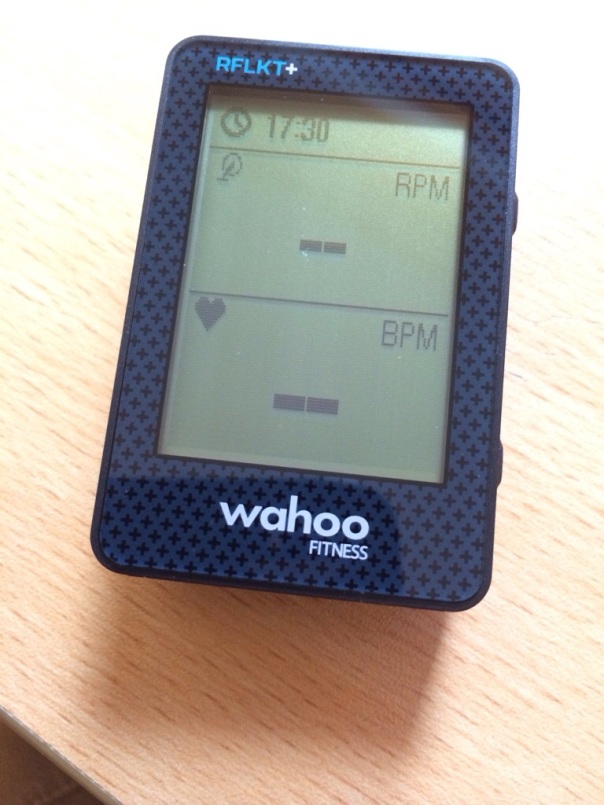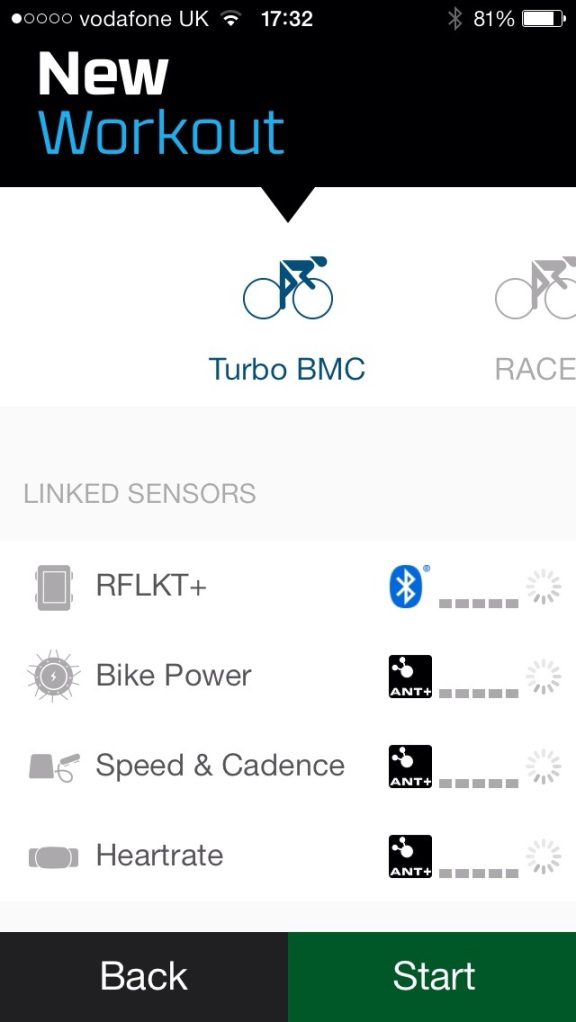Technology – Wahoo RFLKT+
Shortly after I started TTing, I thought to myself wouldn’t it be good to have metrics from my cycling computer spoken into my ear during races? I had a think about how it might be done and what would be necessary:
- Bluetooth earpiece
- Some app running on a smartphone
- A way of getting ANT+ signals (power, speed, cadence, HR) to the phone
Most of these seemed to be in place, at least for Android (There are/were Sony handsets that have a built-in ANT+ receiver chip). I develop software in Java for a living, so I thought maybe I could develop an Android app. But I had and still have an iPhone, it seemed a little too hard to risk time and money on a project like that when I’d be better off training instead. So it went to the back of my mind.
Moving forward to the past couple of weeks, I read a review of the Wahoo RFLKT+ (pronounced ‘reflect plus’) on the quite fabulous DC Rainmaker site. I was aware of the original RFLKT (minus the plus) as a head unit to use with fitness apps on the iPhone, via Bluetooth LE. I already have a Garmin Edge 500, so I never followed up on the RFLKT. But the RFLT+ has a key feature: it bridges ANT+ signals to Bluetooth so they can be processed on an iPhone. Now all we need is a suitable app that will speak this stuff soothingly into my shell-like. Turns out that there’s already a couple – Wahoo’s own Fitness app, and Abvio Cyclemeter. Both of which I already owned.
I took a quick look at the functionality of each and decided that the Wahoo app was superior, mostly because it is so configurable. You can setup a number of ‘announcements’ via separate triggers, either every X seconds/minutes/km etc. That was enough for me to cough up the £110 for the RFLKT+. Wahoo stuff really is excellent and their customer service I’ve found very responsive in the past.
The RFLKT+ came within a couple of days of ordering and I set about seeing if I could integrate all this stuff together. I have the ANT+ devices, the RFLKT+, the iPhone (5S) and a couple of apps to test it with.
It was straightforward to connect it to the Wahoo Fitness app on my iPhone and I mounted the RFLKT+ on my TT bike on the turbo to see how it worked. The answer at the moment I’m afraid, is not very well 😦
I should say first that the version of the app I am running has been updated in the past 24 hours. I now have 4.0, which I presume is a major release. I didn’t ever get to test it with the previous version though, so I don’t know if the flaws have been present for a while, or if they are new at version 4.0. I will say that IF the app worked as I think is intended, it would fulfil my needs and more. I can imagine using it for all my training, since it seems to support lots of different bike profiles, each of which you can setup custom display screens for. It’s incredibly well thought-out. But whilst the app is hugely configurable, there are a number of bugs or missing features that will at worst prevent me from using it, and at best annoy me a little. In order of importance to me, these are:
- Several obvious metrics seem to be missing from the app altogether. There is no average lap power, or average power over various durations (e.g. 3 seconds, 10 seconds, 30 seconds etc.) These are the metrics that I find most useful – indeed the whole purpose of this experiment is to get average lap power and 3 second power (5 second would suffice too) into my ear to help me with pacing. I think this must be an oversight in v4.0 of the app – there are plenty of power metrics, including some quite obscure ones, but the most obvious and useful statistics (to me, at least) are missing.
- The Wahoo Fitness app will not read cadence from my power meter. I have a speed/cadence sensor, but I don’t connect the cadence magnet because I have to position the sensor out of reach of the cranks on my TT bike. Abvio Cyclemeter does read cadence from the Power2Max via the RFLKT+, so it must be an issue with the Wahoo Fitness app itself.
- On the turbo, the auto-pause feature does not kick in until the back wheel has been still for about 15 seconds. I haven’t tested this outdoors yet, but since it uses the wheel speed sensor rather than GPS, it should behave the same. This feature is critical for races, because I need the computer to auto-start when I start the race – I can’t be pressing buttons as I’m being held up at the start line.
- I need to be able to export data from the app so I can import it into Golden Cheetah running on my mac. The app supports Dropbox export which is absolutely ideal, except it doesn’t work. It won’t let me login to Dropbox via the phone, giving the error message ‘Only a limited number of users can get access while this app is in development mode”. This sounds like it will be an easy fix for Wahoo.
- The app frequently crashes when you’re in the configuration pages for external devices (like the power meter). This isn’t a huge deal, since you don’t need to configure those things very often. But it is a worry. If I’m going to use this technology in races, I need to be very confident that it is going to behave.
- Sometimes it has taken upto 2 minutes to find my devices. It sits there spinning searching for them and then after a variable amount of time, it finds them all within a few seconds. Again that can be filed under ‘annoying’, since I am used to having to wait for the Garmin to find a GPS signal before riding.
Most of these seem like solvable problems. I understand the difficulties in getting all this stuff working properly and talking together. It’s disappointing that it didn’t work out of the box, but I’m pretty sure that Wahoo will solve the problems and I will update this post as and when progress is made. I’m quite excited that I seem to be in touching distance of getting this working, and without really lifting a finger myself!
Thanks for reading 🙂
Posted on March 28, 2014, in Gear. Bookmark the permalink. 4 Comments.


Lost me
________________________________
There’s a first, Dad!
How much does all that weigh?
The RFLKT+ is a little lighter than the Garmin Edge 500. The additional weight is the iPhone 5S itself. For general riding, I take that with me anyway, but it is additional weight to carry when racing.
I’ve not carried my phone in a race before, and it makes me feel exposed as if I had an incident I wouldn’t be able to contact anyone. So from that point of view, it’d be good to start carrying it. And I don’t really care about the weight of the phone in a race. The chief concern is where to store it without creating drag.